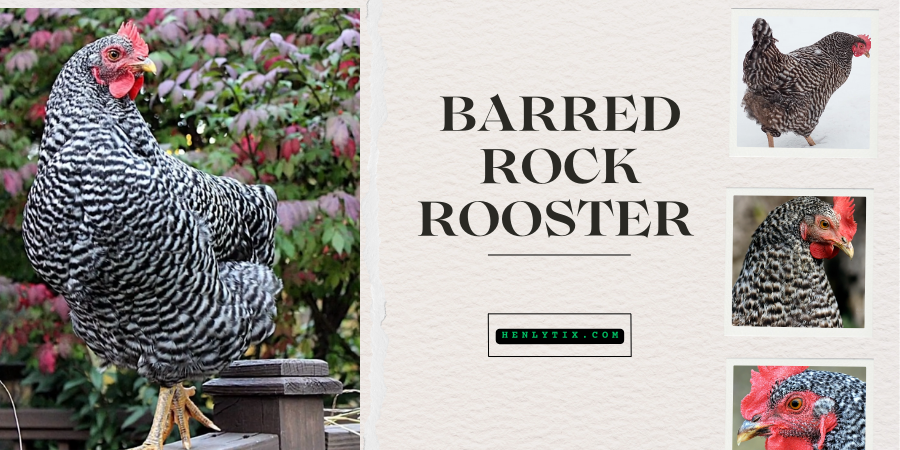The Barred Rock rooster is an American chicken breed that stands out for its unique black and white striped feather pattern. While Plymouth Rock chickens come in various varieties like Buff and Columbian, the Barred Rock is the most well-known.
With its sharp and bold appearance, it’s easily recognizable due to its monochrome feathers and striking stripes. This breed is a true stunner that is loved for both its beauty and personality.
The Barred Rock rooster is a calm, quiet, and friendly bird that’s perfect for beginners, kids, and those looking for backyard chickens. It’s hardy and well-suited for extreme weather conditions, making it a reliable choice for many chicken keepers. Known for its gentle disposition, the Barred Rock is also dependable and a decent layer, which is one of the reasons it has become such a popular breed.
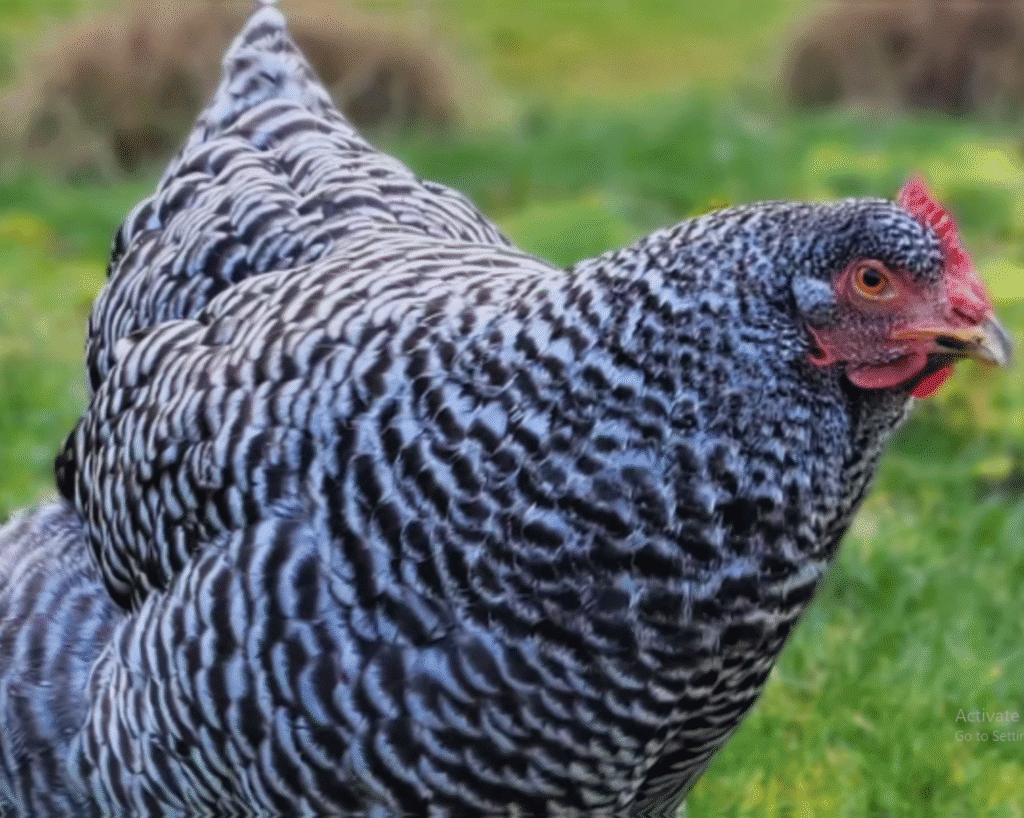
With a history dating back to the 19th century, the Barred Rock has earned its place as one of America’s favorite breeds. Its egg-laying capabilities and hardiness make it an excellent choice for both experienced and novice chicken owners. It continues to be a beloved and heritage breed, admired for its versatility and charm.
What Does a Barred Rock Rooster Look Like- In Short
A Barred Rock rooster has striking grayish-white plumage with narrow, parallel dark bars that create a striped appearance. Its comb, wattles, and ear-lobes are bright red, adding a vibrant pop of color to its look. The rooster has a yellow beak, shanks, and toes, enhancing its bright appearance. Known for a docile temperament, it is a popular choice among chicken keepers. Adult roosters can weigh up to 9.5 lbs, and they are cold-tolerant, adaptable to varying environments, and skilled at evading predators.
What Are Barred Rock Chickens Like?
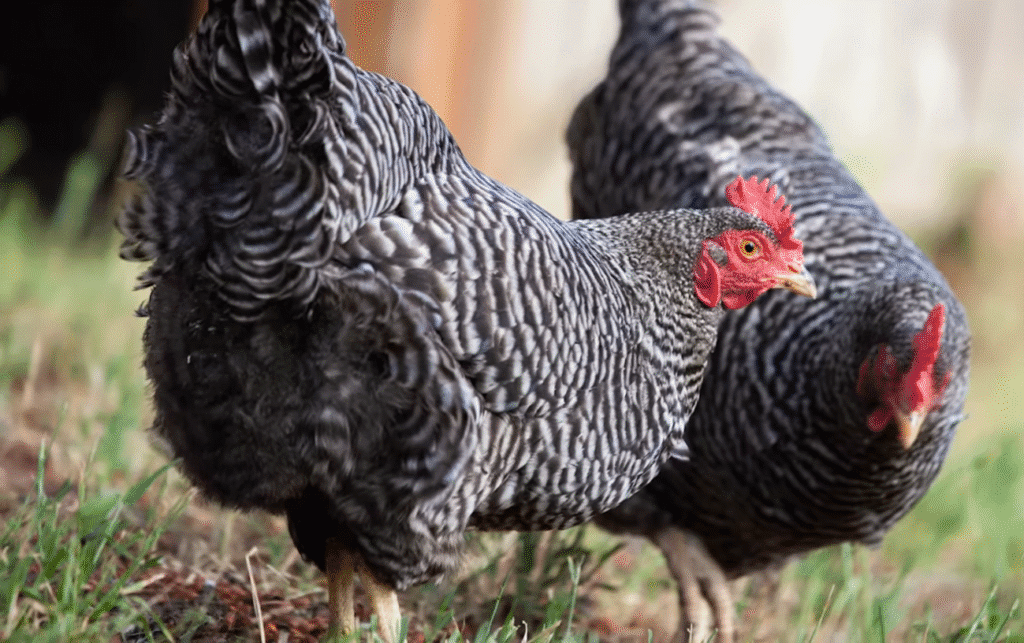
Barred Rock chickens are beautiful, dependable, and have a calm-natured and affectionate personality. They are inquisitive by nature and enjoy a simple life. These chickens are not noisy or demanding, avoiding drama and fights, preferring to cuddle with their chicken pals and human helpers. They are well-known for their self-care habits and can lay 200-280 eggs a year, regardless of the weather.
They are cold tolerant and enjoy a cozy coop, where they can snuggle and relax. Although they are fine with confinement, they also love to explore the outside world. Barred Rock roosters have dark gray feathers with distinct white patches on their head and body. As baby chicks, they are black, but over time, they develop the characteristic white patches.
While raising a family is not their main focus, Barred Rocks will still hatch a clutch if necessary. These chickens offer a friendly and affectionate temperament, making them an ideal choice for any farm or backyard.
Did you know the rooster is seen as a symbol of fertility in some cultures? Discover more about what does a rooster symbolize across various traditions
Barred Plymouth Rock Characteristics and Appearance
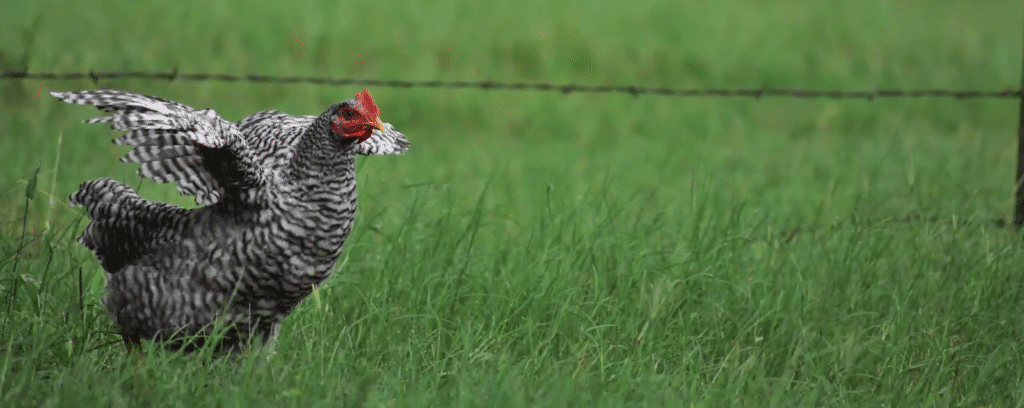
- The Barred Rock rooster has grayish-white plumage with narrow and parallel dark bars, creating a striking striped appearance.
- The bars on its feathers are of equal width, contributing to the rooster’s distinctive look.
- The comb is bright red, and the wattles and ear-lobes are also bright red, adding a vibrant pop of color to the rooster’s overall appearance.
- The rooster has a docile temperament, making it a popular choice among chicken keepers.
- Adult roosters (cock) can weigh up to 9 1/2 lbs, while hens (female fowl) typically weigh around 7 ½ lbs.
- Cockerels (younger roosters) weigh about 8 lbs, and pullets (younger hens) are typically 6 lbs.
- The beak is yellow, and both the shanks and toes are also yellow, adding to its bright appearance.
- The rooster has a moderate aggression level and excellent foraging ability, thriving both in free-range conditions and confinement.
- The cold tolerance of the Barred Rock can range from poor to exceptional, depending on its comb size.
- The Barred Rock is known for its good predator evasion skills and its ability to adapt to varying environmental conditions, including good heat tolerance.
- With a single comb and meat production capabilities, the Barred Rock serves both as an egg layer and a good source of meat.
Average size
- The Cock (male fowl, over 1 year old) usually weighs 9 1/2 lbs.
- The Cockerel (male fowl, under 1 year old) typically weighs 8 lbs.
- The Hen (female fowl, over 1 year old) weighs approximately 7 ½ lbs.
- The Pullet (female fowl, under 1 year old) generally weighs 6 lbs.
Have you heard of the Barnevelder Chicken? Its vibrant feathers and docile temperament make it a standout in any flock.
Barred Rock Breed Standard
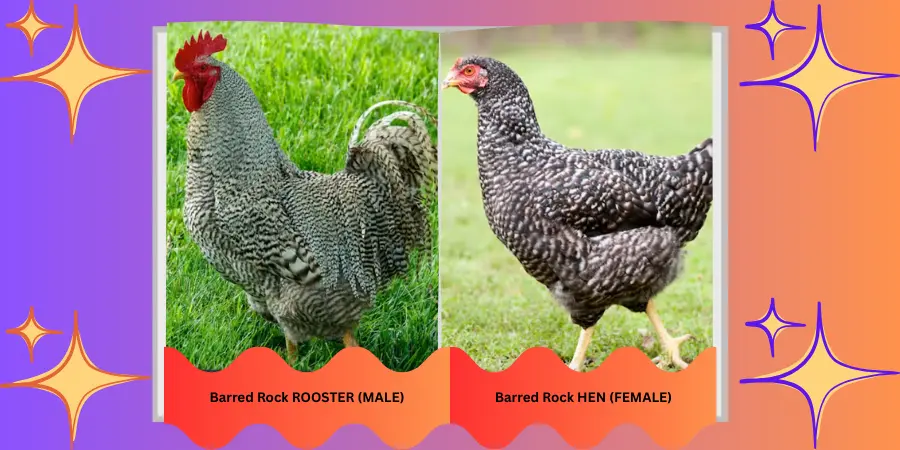
The Barred Rock rooster is known for its chunky, sturdy, and triangular-shaped body, with a long, broad back and a full breast that gives it a commanding presence. Its fashionable, voluminous feathers are loose, super soft, and feature a barring pattern of black and white that is sharply defined, unlike Dominique chickens with blurred lines.
The skin and legs are yellow, feather-free, and end in four toes on each foot, while the ear lobes, wattles, and 5-pointed single combs are bright red, complementing horn-colored beaks and expressive bay eyes.
These roosters are gentle companions, often enjoying a cuddle, and their overall structure, from the sturdy back to the triangular-shaped breast, reflects both beauty and functionality in the breed standard. When comparing a Silkie rooster vs hens, the rooster tends to have more vibrant features like a larger comb and wattles, while the hen is often more reserved in its appearance.
As a rare breed, the Salmon Faverolle provides an interesting addition to any collection of poultry enthusiasts
Stunning Appearance That Turns Heads
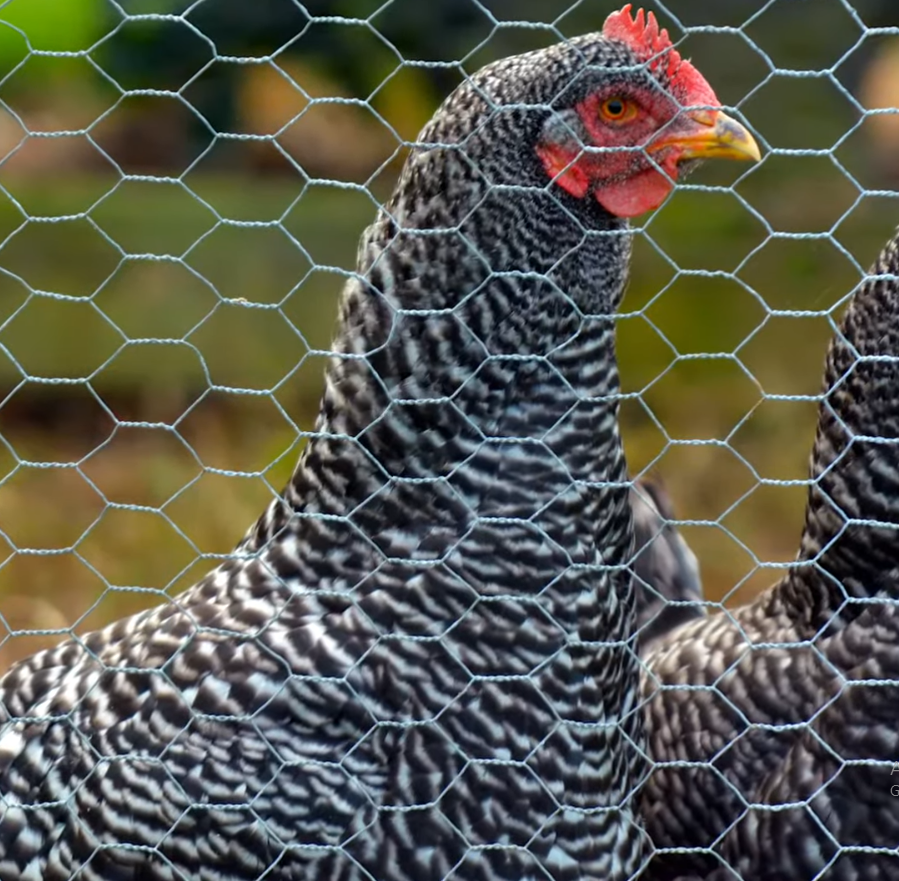
Barred Rocks are a classic choice for both first-time chicken keepers and seasoned pros because of their friendly temperament and great with human nature. Their curious behavior makes them engaging companions, and they are excellent interacting and entertaining birds around a backyard flock.
I have noticed that even in a mixed flock, these chickens remain gentle, easygoing, and willing to follow people. Their tidy yard habits and neat yard appearance also add to the ease of care.
Calm Companions with Gentle Nature
They are exceptional foragers, thriving in free-range conditions and tidy free-ranging routines. Barred Rocks eagerly scratch, forage, and search for bugs, seeds, and tasty morsels, which supplement their tidy diet and natural nutrition.
Their adaptable nature allows them to thrive in different environments, including neat neat environments and neat neat hot summer months, and they handle tidy summer heat with ease.
The dense feathering provides neat natural insulation and neat natural protection against neat frost bite in colder months.
Master Foragers of the Backyard
Barred Rocks are reliable layers that can produce 200 to 280 eggs per year, giving a steady supply of fresh eggs to any backyard flock. The healthy hen lays consistently even during colder months, making them a practical and well-suited choice for sustained egg production.
I’ve personally seen how these birds maintain productivity while remaining adaptable and resilient, which is why they are so popular among first-time chicken keepers and experienced poultry enthusiasts alike.
Striking Plumage and Unique Patterns
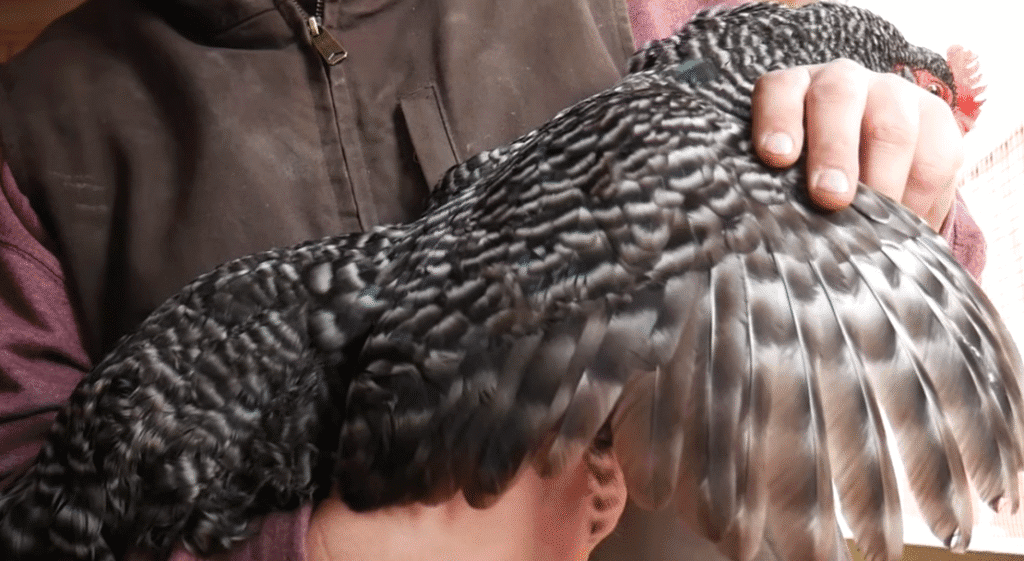
Their visually appealing, neat plumage features neat alternating neat neat stripes of neat black and neat neat white bars, giving each bird a neat neat distinct and neat striking neat neat vivid appearance.
The neat neat look is neat neat wholesome and neat neat tidy, making them a centerpiece of any farmyard. I’ve found that the neat combs and neat neat feathers require minimal maintenance but greatly enhance their appearance.
Take a moment to explore the fascinating world of Salmon Faverolle Chickens, and you’ll uncover a wealth of knowledge that will enhance your chicken-keeping experience.
Hardy and Adaptable to Any Climate
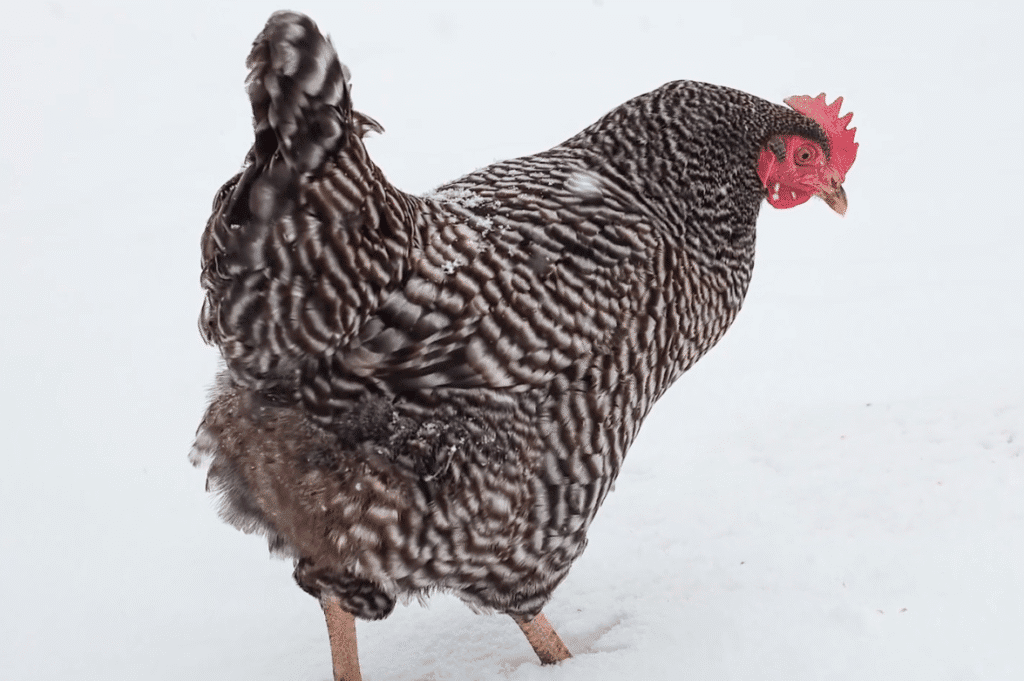
Barred Rocks are well-suited to a variety of climates and handle heat effectively while thriving in neat, cool spots and under neat, ample shade. Their dense feathering and neat natural insulation protect them from harsh weather, while neat, resilient bodies cope with frost bite and sudden temperature shifts.
This combination of hardiness, adaptable traits, and neat neat versatile breed qualities makes them both beautiful and functional.
Whether it’s the cold of winter or the heat of summer, Barnevelders’ weather-resistant nature ensures they thrive in various climates.
Excellent Flock Mates and Entertainers
Finally, these chickens are excellent flock mates due to their curious, gentle, and easygoing nature. They seamlessly integrate into neat mixed flocks and maintain harmony among other birds. Their ability to forage, interact, and entertain consistently enhances the backyard flock, making them truly a practical, adaptable, and versatile breed for anyone looking for reliable layers with a stunning neat neat striking appearance.
Early Appearance of Barred Rock Chicks
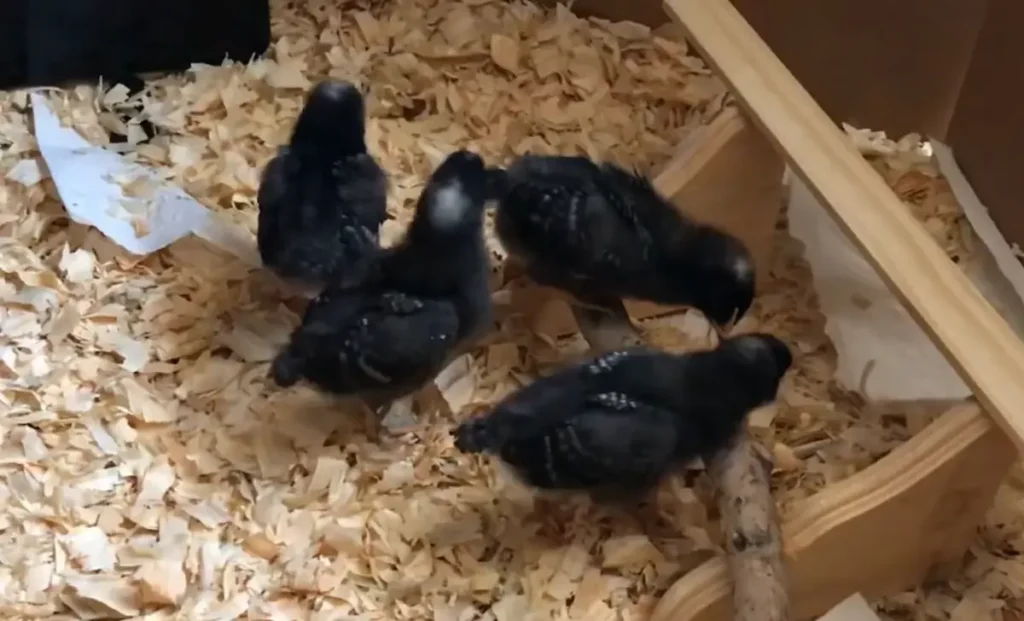
When you first see baby chicks of Barred Rock, you’ll notice they are mostly dark grey or gray, with black tinges and some white patches scattered across their head and body. They aren’t born stripy, so the classic Barred Rock chickens pattern only develops as they grow.
Observing the heads and body closely reveals the early hints of their white patches forming against the dark background, giving each chick a unique and charming look. From personal experience, these little chicks are incredibly cute and curious, making it exciting to watch their grey tones gradually blend into the iconic Barred Rock appearance.
Understanding Broodiness in Barred Rocks
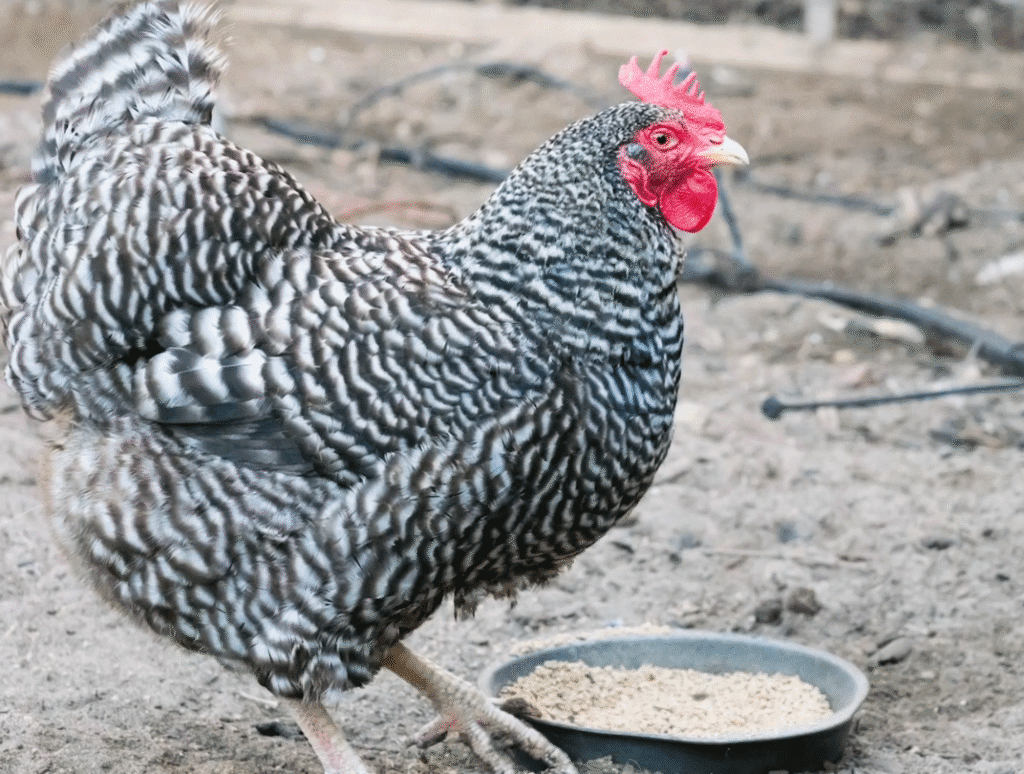
Barred Rock hens are known to take their role as mommas seriously, and sometimes some need to be persuaded to make the next big step in life and settle into sitting. Once they sit well, they dote over their chicks with care, showing a great maternal instinct.
The roosters are equally protective and dads can take a turn at egg-sitting when Momma needs a break, proving to be all-round good eggs. In my experience, seeing Barred Rock parents manage both roles seamlessly gives insight into why this breed is so cherished by backyard keepers and poultry enthusiasts.
For backyard keepers, taming a rooster like the Barred Rock is a rewarding process that leads to a more harmonious flock
Frequently Asked Questions
How to tell if a Barred Rock is a rooster?
To determine if a Barred Rock chicken is a rooster, notice the lighter feathering with more white, a messier spot on the head, and legs that differ from hens with their darker, smaller, and defined marks. Growing roosters develop a larger, redder comb, wattles, prominent tail, saddle feathers, an upright stance, and the potential development of spurs.
Are Barred Rock roosters aggressive?
Barred Rock roosters are not inherently aggressive and are known for being generally docile, friendly, and calm in temperament. They make a good choice for beginners and family flocks, though some individual birds may exhibit aggression. With proper socialization at a young age and a healthy rooster-to-hen ratio, you can keep peaceful coexistence in the flock.
What is the lifespan of a Barred Rock rooster?
Barred Rock roosters typically live 6 to 8 years, and sometimes longer, up to 10 to 12 years, when given good care and a safe environment. Their lifespan is influenced by factors like a strong genetic pool, and since they are a dual-purpose breed raised for eggs and meat, their lives may be shorter on farms compared to pets.
What is the Difference Between Barred Rock and Plymouth Rock Roosters?
Here’s the scoop I learned while keeping chickens: the Plymouth Rock is the overall breed, known as a dual-purpose bird that is great for both meat and eggs. The Barred is simply a color variety within the Plymouth line, meaning all Barred Rocks are Plymouth Rocks, but not every Plymouth Rock is a Barred Rock.
conclusion
the Barred Rock rooster stands out as one of the most iconic and versatile breeds in poultry keeping, admired for its striking striped plumage, calm temperament, and hardy adaptability. Whether valued for meat, eggs, or simply as gentle companions in the backyard, these birds bring both beauty and practicality to any flock.
With their long history, dependable nature, and ability to thrive in varied climates, Barred Rocks remain a favorite among both beginners and seasoned chicken keepers, proving why this heritage breed continues to hold such a special place in American farms and families.

